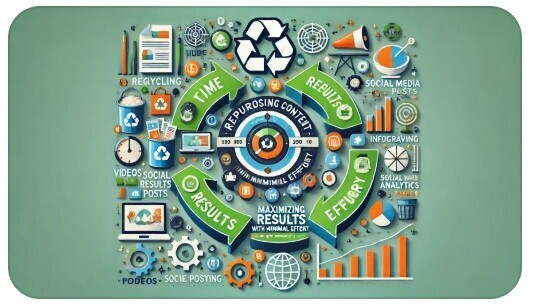
Content repurposing isn’t just a buzzword; it’s a smart strategy to squeeze more value out of every piece you create. Picture this: you’ve got a killer blog post that’s doing well. You could leave it as is, or you could transform it into several formats, extending its reach to new audiences and platforms. This way, one piece of content works harder to bring in more results.
Why does content repurposing matter? For starters, it saves both time and resources. Instead of always creating from scratch, you refresh and rejuvenate existing content. But it’s not just about efficiency. Repurposing can revitalize your brand’s message, ensuring it resonates with different audience segments no matter where they hang out online.
Think about how brands capitalize on this. A single blog post morphs into a podcast episode, an infographic for social media, or even a video for YouTube. Each format captures distinct audience preferences, and this variety keeps your brand dynamic and compelling.
Incorporating repurposing into your digital strategy amplifies the impact of your efforts significantly. It’s not about reinventing the wheel every time but making the most of what you already have. With a little creativity, repurposing turns potential redundancy into opportunity, pushing your content much further than its original form.
Benefits of Repurposing: Amplifying Your Reach
Repurposing content is like hitting the jackpot on a single spin. By transforming your content for different platforms, you’re effectively broadening the scope and range of who gets to see and engage with it without doubling your workload.
Imagine taking a well-performing blog post and turning it into a lively tweet thread, an insightful newsletter, or a catchy Instagram story. Instantly, you’ve reached new corners of the internet, engaging with people who prefer bite-sized content or who just weren’t finding you through traditional channels.
Another big win here is in the time-saving department. Rather than starting from square one every time, you’re building on what you already have. This approach isn’t just efficient; it’s smart usage of resources, freeing up your team to work on new, creative projects while existing content pulls double duty.
Getting your audience to stick around and engage is key, and repurposing can keep things fresh. Offering your message in diverse formats means you’re catering to different tastes and ways people like to consume content. This boosts engagement as you’re speaking directly to audience preferences, gaining interest and traction organically.
Overall, by varying how and where your content appears, you expand your reach and get your brand’s voice heard louder and clearer across the online world. And who wouldn’t want a little more of that?

Recognizing Untapped Content Potential
Every piece of content you create holds more potential than you might initially see. Unlocking that extra value begins with spotting what’s ripe for repurposing. But how do you decide what gets a new lease on life?
A good starting point is to dig into your content’s performance metrics. Look at what pieces are already hitting the mark in terms of engagement, shares, or traffic. High-performing content is your low-hanging fruit – if it worked once, it can work again in a new form.
Don’t just rely on the numbers, though. Use a bit of intuition and creativity. Maybe there are older pieces that deserve a comeback, especially if audience preferences have shifted or if there’s a seasonal twist to give them new relevance.
Conducting a content audit can be an eye-opener. Review your library and track what’s evergreen and what’s dated but still valuable. Often, the gold is hiding in plain sight, ready to be reshaped into fresh content that captivates anew.
Repurposing isn’t about recycling in the traditional sense; it’s about reimagining. The goal is to extract and amplify the core message in ways that align with different audience vibes and platform norms.
So, take time to sift through your content with an analytical yet imaginative mindset. The insights you gather here will help you spot those rich, untapped veins of opportunity, setting the stage for your content’s next evolution.
Strategies for Effective Content Repurposing
Getting the most out of content repurposing calls for the right mix of creativity and strategic thinking. The ultimate goal is to breathe new life into your content by aligning it with varied formats and audience preferences.
Start by selecting content that aligns well with different formats. For instance, a comprehensive guide can be broken down into short, punchy video segments or a vibrant slideshow for visual platforms like Instagram or Slideshare.
Each platform has its own vibe and audience expectations. Tailoring content to fit these nuances ensures that what you’re offering feels native yet fresh. Pay attention to what kind of content your target audience consumes on specific platforms and go with that flow.
Maintaining consistency across these formats is crucial, though. The core message should remain intact, even as the presentation shifts. Keeping a coherent narrative helps reinforce your brand’s voice, making it recognizable across various mediums.
To make this all work efficiently, it helps to have a rough calendar or plan that outlines how and when content will be repurposed. This avoids the scattergun approach and helps you manage your content’s lifecycle smoothly.
By thoughtfully planning your repurposing strategy and aligning it with the distinctive characteristics of various platforms, you can maximize impact without ever feeling stretched too thin.

Tools and Technologies to Aid Repurposing
Navigating the content repurposing landscape doesn’t have to be overwhelming, especially with the right tools in your arsenal. These can simplify the process, making your content transformation journey smoother and even automated in some cases.
For starters, using social media management tools like Buffer or Hootsuite can help schedule and distribute repurposed content across multiple platforms without a hitch. You upload once, and these tools take care of the timing and posting, keeping your presence consistent without manual drudgery.
Do you have a blog that needs to become a podcast episode? Look into tools like Audacity or Anchor. They provide easy ways to record and publish audio content, bridging the gap between written and spoken word seamlessly. This shift can open up a whole new audience who prefer listening.
When it comes to creating visual content, tools like Canva can be invaluable. With pre-made templates tailored for all major platforms, creating engaging infographics or social media assets from existing content becomes a breeze, even if graphic design isn’t your strongest suit.
Finally, leveraging AI and analytics is a game-changer. Tools like Google Analytics or HubSpot not only help in tracking how well-repurposed content performs but can also give insights into what types of formats might engage your audience best. Here, data fuels your decisions, ensuring your repurposing strategies are both informed and effective.

Measuring Success and Iterating on the Process
Once you’ve started down the path of repurposing, knowing how to measure success is key. Gauging the performance of repurposed content requires a set of clear metrics. You’ll want to focus on engagement rates, views, conversions, and shares to understand what’s hitting the mark and what’s not.
Feedback loops are invaluable here. By regularly checking audience reactions through comments, likes, or direct feedback, you gather valuable insights that tell you how well your content resonates. These insights are worth their weight in gold when refining future repurposing efforts.
Another smart move is to set up A/B tests. Try out different content formats or delivery methods to see which ones your audience gravitates toward. This not only helps in fine-tuning existing strategies but also uncovers new, untapped opportunities you might not have considered initially.
Case studies are also great for learning. Look at how other brands have used repurposing to achieve their goals. Analyzing what worked for them can offer ideas and inspire your own strategies, even helping you avoid potential pitfalls.
Continuously iterate based on what you learn. Don’t be afraid to tweak and experiment; being adaptable ensures that your content remains fresh and aligned with changing audience behaviors and platform dynamics. This ongoing optimization is what will truly maximize your results with minimal effort.
If you want to read more about creating quality content for a website, you can learn how to write quality content here.
To learn more about Howard, you can check out this article.
My involvement in operating an online business started in 2014, and I did not do it alone! Online success takes hard work, perseverance, and help to learn all these things.
The industry is constantly changing, especially with the growth of Artificial Intelligence (AI) in the online world.
If you want to be taught how to create great website content and have an online business that could make you income 24/7, 365, then you may want to check out how I did it. I used this source to learn, engage with others for assistance, and create online income using multiple affiliate marketing sources.
You can also reach out to me by leaving a comment below. I will get back to you!
Can You Afford to Not Make Money Online?

